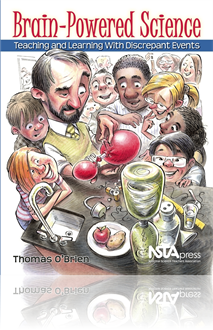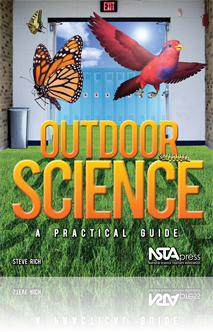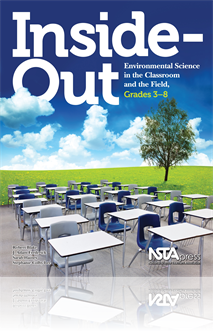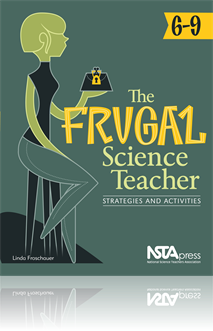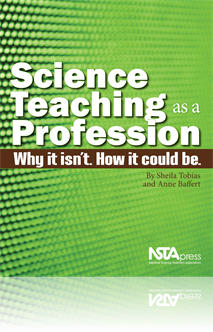All Book Chapters
Book Chapter
Happy and Sad Bouncing Balls: Student Diversity Matters
This activity features two seemingly identical black rubber balls—one happy and one sad—that behave quite differently. The two balls can be used to introduce the National Science Education Standards’ unifying concepts and processes and to rais...
Book Chapter
Electrical Circuits: Promoting Learning Communities
Direct current (DC) electricity flows through a closed circuit of people, and a battery-powered ball lights up. In this activity, the Energy Ball (or UFO Ball) is a Ping-Pong ball look-alike battery-powered ball that produces and converts a small cur...
Book Chapter
Eddy Currents: Learning Takes Time
A metal slug dropped into a copper tube falls under the pull of gravity and drops out at the bottom fairly quickly. When a second, apparently identical, slug is dropped into the tube, it falls quite slowly. If one slug is secretly held in the instruc...
Book Chapter
Cognitive Inertia: Seeking Conceptual Change
Cognitive inertia (or conservatism)—the tendency of humans to continue to think both what and how they have previously thought—applies at both the individual and the scientific community level. This activity features two demonstrations that can b...
Book Chapter
Optics and Mirrors: Challenging Learners' Illusions
Science depends on empirical evidence, logical argument, and skeptical review. Optical illusions challenge us to consider if our eyes sometimes play tricks on us. In this activity, coins dropped into a magic bank appear to shrink in size and fall thr...
Book Chapter
Polarizing Filters: Examining Our Conceptual Filters
If two polarizing filters are placed perpendicular to each other, both horizontal and vertical vibrations will be blocked, allowing little light to be transmitted. In this activity, two polarizing filters are overlaid on an overhead projector. As th...
Book Chapter
Invisible Gases Matter: Knowledge Pours Poorly
Invisible gases are a form of matter that have volume or occupy space. In this activity, water flows down through two identical funnels, each inserted in a two-hole stopper, into two identical flasks. The water flows at very different rates because a...
Book Chapter
The Stroop Effect: The Persistent Power of Prior Knowledge
If learners are asked to state, as fast as they can, the colors of a sequence of words that appear in different colors than the colors named, the first inclination of most is to read the words rather than naming the colors in which the words are prin...
Book Chapter
Rattlebacks: Prior Beliefs and Models for Eggciting Science
In this activity, a translucent, half-ellipsoid-shape, molded acrylic polystyrene object—known as a “rattleback”—is placed on an overhead projector or under a document camera and is observed to spin freely if pushed in a counterclockwise dire...
Book Chapter
Burning a Candle at Both Ends: Classrooms as Complex Systems
This introductory activity models how simple it is to prepare and execute interactive, discrepant-event demonstration-experiments. They can be used daily to activate students’ perceptual attention, catalyze cognitive processing, and energize intere...
Book Chapter
Tornado in a Bottle: The Vortex of Teaching and Learning
In this activity, two 2 L plastic soda bottles are connected at their mouths. Colored water from the upper bottle falls in the lower bottle quickly only after the two bottle system is given a twist to create a spiraling, funnel-shaped vortex. This vi...
Book Chapter
Floating and Sinking: Raising FUNdaMENTAL Questions
Learning science is FUNdaMENTAL—that is, it is a combination of hands-on FUN and minds-on MENTAL activity. It builds on students’ prior knowledge that has been acquired both from formal instruction and from daily life experiences. In this activit...
Book Chapter
Cartesian Diver: A Transparent but Deceptive "Black Box"
An eyedropper “diver”—eyedropper, dropper, diver, and Cartesian diver are used interchangeable in this activity—can be made to float, sink, or remain suspended in the middle of a water-filled, capped, plastic 2 L soda bottle “on command” ...
Book Chapter
Crystal Heat: Catalyzing Cognitive Construction
A small metal clicker/disk within a sealed pouch containing a clear, colorless liquid is clicked, and the liquid rapidly crystallizes into a solid mass and releases a large quantity of heat. If the solidified pouch is allowed to cool back to room tem...
Book Chapter
Perceptual Paradoxes: Multisensory Science and Measurement
Perceptual paradox activities challenge assumptions in ways that are both playful and mentally challenging and that point to the need for quantitative measurements. These activities also demonstrate that human meaning-making always involves both sele...
Book Chapter
Optical Illusions: Seeing and Cognitive Construction
Optical illusions can be used as interactive, everyone-participates demonstrations to show teachers that the act of visual observation is not a passive, mindless, stimulus-response, camera-like operation. Optical illusions challenge simple notions of...
Book Chapter
Utensil Music: Teaching Sound Science
“Sound science” is more than just a play on words—it is a powerful metaphor for the mind-opening and mind-expanding effect of integrated curriculum, instruction, and assessment. This simple, hands-on exploration highlights the fact that hearing...
Book Chapter
Identification Detectives: Sounds and Smells of Science
This simple, hands-on exploration can be used to emphasize the role of sensory perception as a necessary antecedent to mental conception, the nature of science, and the pedagogical value of a “fun phenomena first.” While most hands-on exploratio...
Book Chapter
Two-Balloon Balancing Act: Constructivist Teaching
This activity explores LaPlace’s law where membranes exert pressure on their contents that decrease as the membranes are stretched to larger sizes and their thickness decreases. The internal pressure of a spherical balloon is inversely proportional...
Book Chapter
Batteries and Bulbs: Teaching is More Than Telling
This activity features a simple, three-component system that can be used to explore a variety of concepts including closed versus open electrical circuits and conductors versus insulators. It also can initiate further explanations into the design of ...
Book Chapter
Did you ever look out the window on a nice day and dream about what fun it would be to hold class outside? Your students probably feel the same way! Teaching outdoors is rewarding for both teachers and students, and this chapter offers many options f...
Book Chapter
Does Money Grow on School Yard Trees? Resources for Your Outdoor Classroom
Activities in this book may excite you, but how will you pay for them? Money does not grow on trees—even trees in a school yard. The challenge for environmental educators is to channel grant funds, donations of goods and services, and volunteer hel...
Book Chapter
It All Adds Up! Math + Science + Outdoors = Fun
Creative mathematics teachers will tell you that math is everywhere and science cannot be taught without math. When students are taken outdoors, they will find that math is everywhere. Many of the lessons in this chapter are for math patios, but some...
Book Chapter
Reading and Writing About Nature
The integration of science and language arts is an effective way for teachers to enhance students’ comprehension and critical thinking and the requirements of curriculum. Both writing and reading can be readily emphasized during science lessons. Th...
Book Chapter
Social Studies: Humans and the Outdoors
The history of humans interacting with the land is the perfect context for a number of outdoor learning experiences. Humans have relied on the Sun to tell time or on plants to provide food sources, shelter, and clothing. Science as a human endeavor a...
Book Chapter
This chapter introduces the topic of topography, including map use and interpretation. Activities are provided to help students apply their understanding of the topic to the form and structure of the actual landscape....
Book Chapter
Physical geography becomes a way to identify and better understand the components in the environment and the structure of the landscape. The activities in this chapter will help students build on their observational skills and begin to use interpreta...
Book Chapter
The focus for this chapter is soil, and the activities investigate the general soil characteristics of color, structure, and texture. Students learn that an examination of the soil can tell much about the area under investigation. Learning about soil...
Book Chapter
This chapter explores the concepts of energy and nutrients and goes back to the fundamental connection of these concepts with the environment. Activities are provided that help students design their own experiments to explore simple, but important, c...
Book Chapter
Biodiversity can be defined as the variation of taxonomic life forms within a given ecosystem or biome, or for the entire Earth. It can be used as a measure of the health of an ecosystem, to indicate what has existed from past to present, and to use...
Book Chapter
Action projects are an invaluable way to engage students in authentic, real-life application of the concepts they have learned relating to the environment and a wonderful means of instilling a sense of environmental stewardship.This chapter offers su...
Book Chapter
The intent of this chapter is not to review the literature that justifies and rationalizes the implementation of field-based learning experiences for elementary and middle school students and teachers. The authors instead provide narrative statements...
Book Chapter
Making Mendel’s Model Manageable
Genetics is often a fascinating but difficult subject for middle level students. They can see the results of genes in every organism, but trying to visualize what happens at the level of genes is challenging for concrete thinkers. This activity prese...
Book Chapter
The impetus for this book and for much of the nation’s conversation during recent years about the impending “shortfall” of science teachers was the publication in 2007 of a National Academy of Sciences study, provocatively titled Rising Above t...
Book Chapter
How Did Teaching First Gain and Then Lose Its Professional Status?
There is widespread agreement that science teaching is more than a career—it’s a “calling,” and it’s the “discovery” that hooks teachers into doing science. This chapter presents “The Elements of the Profession” sidebar, and if one...
Book Chapter
The Long Shadow of No Child Left Behind
The No Child Left Behind Act was signed into law January 2002, and started a multistate effort to push for “accountability” in the nation’s locally controlled schools—all U.S. students needed to achieve grade-level reading and math proficienc...
Book Chapter
Ongoing Efforts to Elevate Teachers' Capability and Status
The publication of A Nation at Risk: The Imperative for Educational Reform in 1983, was more than just another report on the need for school reform. In this chapter, the authors examine the impact on teachers and teaching of some reforms, that, unlik...
Book Chapter
Engaging Science Teachers in the Wider World of Science
This chapter focuses on how secondary science teachers can remain connected—as professionals—to science and scientists. It features four programs designed to do this, all based on a similar rationale, namely, that secondary science teachers need ...
Book Chapter
Science Teaching Elsewhere: Spotlight on Finland
The United States competes with graduates from other countries. In this chapter, the authors pose the question: What can we learn from their systems, particularly with regard to science teaching as a profession? The chapter focuses on one European c...
Book Chapter
Empowering Science Teachers to Lead
For too long, teachers have allowed others to make work-related decisions for them. Science teachers need to see themselves as the key to the success of the educational enterprise. This chapter provides the first steps teachers need to take to be hea...



